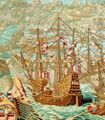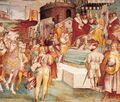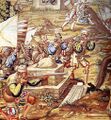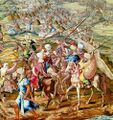الغارة على تونس
| الغارة على تونس | |||||||||
|---|---|---|---|---|---|---|---|---|---|
| جزء من الحروب العثمانية-الهابسبورگية والحروب البرتغالية-العثمانية | |||||||||
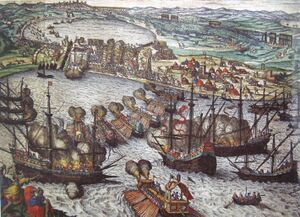 Attack on La Goletta, with Tunis in the background 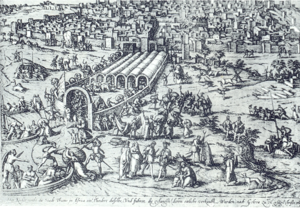 Entry of Charles V, Holy Roman Emperor, into Tunis in 1535 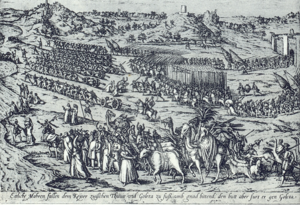 شارل الخامس ينزل في رادس (بريشة Jan Cornelisz Vermeyen) | |||||||||
| |||||||||
| المتحاربون | |||||||||
|
|
| ||||||||
| القادة والزعماء | |||||||||
|
|
| ||||||||
| القوى | |||||||||
|
إجمالي العديد: 60,000 السفن: |
| ||||||||
| الضحايا والخسائر | |||||||||
| الكثيرون سقطوا بمرض الدسنتاريا | على الأقل 30,000 مدني لقوا مصرعهم | ||||||||
غزو تونس كان غارة على مدينة تونس, التي كانت تحت سيطرة الدولة العثمانية, شنتها الامبراطورية الإسبانية في 1535.[6]
خلفية
In 1533, Suleiman the Magnificent ordered Hayreddin Barbarossa, whom he had summoned from Algiers, to build a large war fleet for Constantinople.[7] Altogether 70 galleys were built in the winter of 1533–1534, manned by slave oarsmen, including 2,000 Jews.[8] With this fleet, Barbarossa conducted aggressive raids along the coast of Italy, then conquered Tunis on 16 August 1534, ousting the theretofore local ruler, Muley Hasan, who had been subservient to the Spanish[9][10] Barbarossa established a strong naval base in Tunis, which could be used for raids in the region, and on nearby Malta.[9]
Charles V assembled a large army of some 30,000 soldiers, 74 galleys rowed by chained Protestants[محل شك] shipped in from Antwerp,[11] and 300 sailing ships, including the carrack Santa Anna and the Portuguese galleon São João Baptista (the most powerful ship in the world at the time) to drive the Ottomans from the region.[12] The expense involved for Charles V was considerable, and at 1,000,000 ducats on par with the cost of Charles' campaign against Suleiman on the Danube.[13] Unexpectedly, the funding of the conquest of Tunis came from the galleons sailing in from the New World, in the form of two million gold ducats extracted by Francisco Pizarro for releasing the Inca king Atahualpa, whom he nevertheless executed on 29 August 1533.[13]
Despite a request by Charles V, Francis I denied French support to the expedition, explaining that he was under a three-year truce with Barbarossa following the 1533 Ottoman embassy to France.[14] Francis I was also in negotiations with Suleiman the Magnificent for a combined attack on Charles V following the 1534 Ottoman embassy. Francis I only agreed to Pope Paul III's request that no fight between Christians occur during the time of the expedition.[14]
المعركة
في 1535, بدأ العثمانيون بقيادة خير الدين برباروسا مهاجمة السفن المسيحية في البحر المتوسط، انتقاماً لمحاكم التفتيش لمسلمي الأندلس، منطلقين من قاعدتهم في مدينة الجزائر. في تلك السنة استولى على تونس ليتخذها قاعدة تموين للمزيد من الحملات البحرية في المنطقة. شارل الخامس , أحد أقوى الرجال في اوروبا في ذلك الوقت, جمع جيشاً جراراً قوامه 60,000 جندي ليطرد العثمانيين من المنطقة وليواصل الانتقام من المسلمين في شمال أفريقيا. محمياً بالأسطول الجنوي, دمر شارك الخامس أسطول برباروسا[بحاجة لمصدر] وبعد حضار باهظ لكن ناجح عند حلق الوادي, استولى على تونس. على إثر ذلك قام بمذبحة في مدينة تونس راح ضحيتها أكثر من 30,000 شخص.
الحصار أظهر في ذلك الوقت استعراض قوة أسر هابسبورگ آنئذ; فشارل الخامس كان تحت سيطرته معظم جنوب إيطاليا, صقلية, إسبانيا, الأمريكتين, النمسا وأراضٍ في ألمانيا. بالإضافة إلى ذلك, فقد كان امبراطوراً رومانياً مقدساً وكان له سيطرة قانونية de jure على معظم ألمانيا كذلك.

تبعات الغزو
Barbarossa managed to escape to the harbour of Bône, where a fleet was waiting for him. From there, he sailed to accomplish the Sack of Mahón, where he took 600 slaves and brought them to Algiers.[15]
العثمانيون ردوا باستعادة المدينة في 1574. إلا أن الحكام العثمانيين لتونس بايات شبه مستقلين عملوا ك privateers ضد الملاحة المسيحية (باستثناءات). وبالتالي, فالغارات في المتوسط تواصلت حتى أخضع الفرسيون المنطقة كمحمية بعد ثلاثة قرون.
A French invasion led to the establishment of French Algeria in 1830, consequently France would create a protectorate over Tunisia in 1881.
معرض صور
Charles V going to Radès
Charles V announcing the capture of Tunis to Pope Paul III in 1535
Imperial troops in the conquest of Tunis, 1535, Jan Cornelisz Vermeyen
انظر أيضاً
- قراصنة الساحل البربري
- Battle of La Goleta
- Journey of Algiers
- Siege of Castelnuovo
- معركة جربة
- حصار مالطة
- معركة لـِپانتو
- الحروب العثمانية-الهابسبورگية
- الحروب البرتغالية-العثمانية
هامش
- ^ Roger Crowley, Empires of the Sea, faber and faber 2008 p. 61
- ^ History of the Ottoman Empire and modern Turkey Ezel Kural Shaw
- ^ 15 قادس من سرب البحر المتوسط, 42 سفينة من الأسطول الكنتابري, 150 سفينة من سرب ملقة
- ^ Crowley, p. 61
- ^ Garnier, p. 96
- ^ Bruce Ware Allen, "Emperor vs. Pirate Tunis, 1535." MHQ: Quarterly Journal of Military History (Winter 2014) 26#2 pp 58–63.
- ^ Crowley, p. 56
- ^ Crowley, p. 57
- ^ أ ب Crowley, p. 58
- ^ Also known as Muleassen in Italy, and Abu-Abd-Allah-Mohammed-el-Hasan in Tunis. Il Palazzo di Fabrizio Colonna a Mezzocannone, article by Bartolommeo Capasso in Napoli nobilissima: rivista di topografia ed arte napoletana, Vol. 1–3, pp. 100–104.
- ^ Crowley, p. 59
- ^ Crowley, p. 60
- ^ أ ب Crowley, p. 62
- ^ أ ب Garnier, pp. 94–95
- ^ E.J. Brill's first encyclopaedia of Islam 1913–1936 by M. Th. Houtsma p. 872
المصادر
- Battle: a Visual Journey Through 5000 Years of Combat. Grant, R. G. 2005
- La Marina Cántabra. Ballesteros-Beretta, Antonio. 1968
- [www.cervantesvirtual.com Cervantes Virtual]
